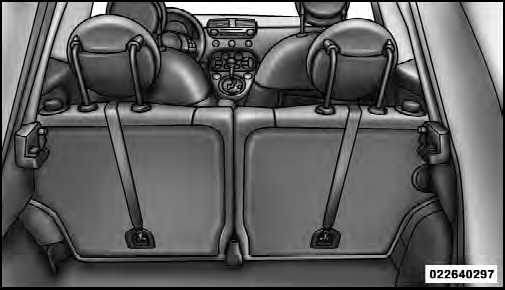The seat belts in the passenger seating positions are equipped with an Automatic Locking Retractor (ALR) to secure a Child Restraint System (CRS). These types of seat belts are designed to keep the lap portion of the seat belt tight around the child restraint so that it is not necessary to use a locking clip. The ALR will make a ratcheting noise if you extract the entire belt from the retractor and then allow the belt to retract into the retractor. For additional information on ALR, refer to “Automatic Locking Mode” description under “Occupant Restraints.” The chart below defines the seating positions with an Automatic Locking Retractor (ALR) or a cinching latch plate.

Installing a Child Restraint with an ALR: 1. To install a child restraint with ALR, first, pull enough of the seat belt webbing from the retractor to route it through the belt path of the child restraint. Slide the latch plate into the buckle until you hear a “click.” Next, extract all the seat belt webbing out of the retractor and then allow the belt to retract into the retractor. As the belt retracts, you will hear a ratcheting sound. This indicates the safety belt is now in the Automatic Locking mode.
2. Finally, pull on any excess webbing to tighten the lap portion around the child restraint. Any seat belt system will loosen with time, so check the belt occasionally, and pull it tight if necessary.
• In the rear seat, you may have trouble tightening the lap/shoulder belt on the child restraint because the buckle or latch plate is too close to the belt path opening on the restraint. Disconnect the latch plate from the buckle and twist the short buckle-end belt several times to shorten it. Insert the latch plate into the buckle with the release button facing out.
• If the belt still can’t be tightened, or if pulling and pushing on the restraint loosens the belt, disconnect the latch plate from the buckle, turn the buckle around, and insert the latch plate into the buckle again. If you still can’t make the child restraint secure, try a different seating position.
To attach a child restraint tether strap:
• Route the tether strap under the head restraint to provide the most direct path for the strap between the anchor and the child seat.

Tether Straps
Routed To Tether Anchors
• If necessary, move the seat forward to provide better access to the tether
anchor.
• Attach the tether strap hook of the child restraint to the tether anchor. Remove
slack in the tether strap according to the child restraint manufacturer’s instructions.
![]() NOTE: Ensure that the tether strap does not slip into the opening between the
seatbacks as you remove slack in the strap.
NOTE: Ensure that the tether strap does not slip into the opening between the
seatbacks as you remove slack in the strap.
![]() WARNING!
WARNING!
An incorrectly anchored tether strap could lead to increased head motion and possible injury to the child. Use only the anchor position directly behind the child seat to secure a child restraint top tether strap.
See also:
High temperature engine coolant fluid
(red)
Turning the ignition key to MAR the warning light turns on, but it should go
off after few seconds.
The warning light turns on when the engine is overheated.
If the warning light comes on ...
Jump-Starting Procedure
If your vehicle has a discharged battery, it can be jumpstarted using a set of
jumper cables and a battery in another vehicle or by using a portable battery booster
pack. Jump-starting can be dang ...
12. Charging System Light
This light shows the status of the electrical charging system. The light should
come on when the ignition switch is first turned to ON/RUN and remain on briefly
as a bulb check. If the light sta ...


